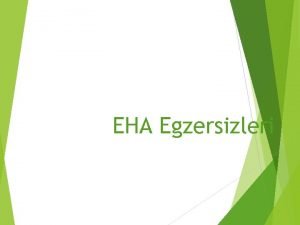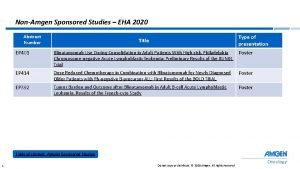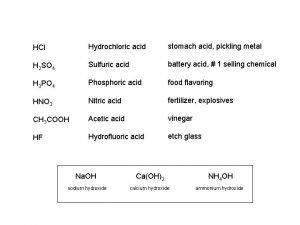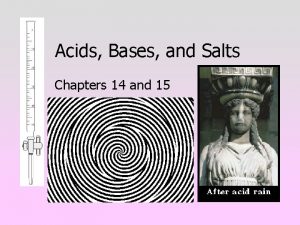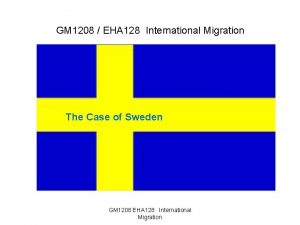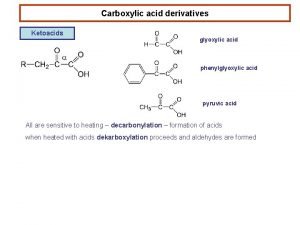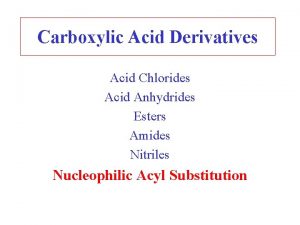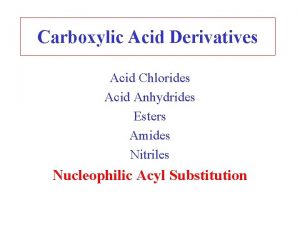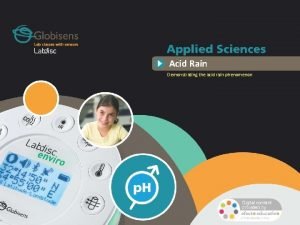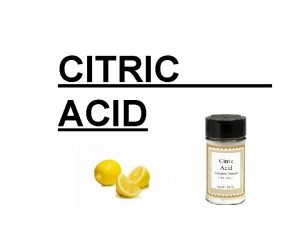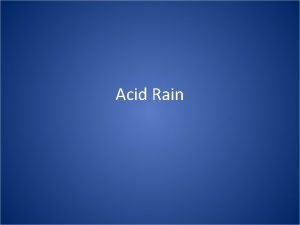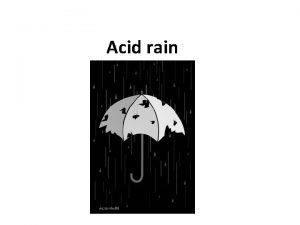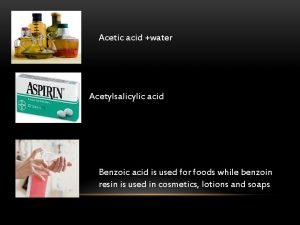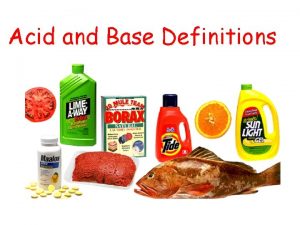Issue Ethylhexanoic Acid Issue 2 EHA Again a












- Slides: 12

Issue: Ethylhexanoic Acid Issue: 2 -EHA Again a contaminant found in food jars Ernährungsphysiologie und angewandte Biochemie T. J. Simat, Institut für Lebensmittelchemie, TU-Dresden, Oktober 2004 1

2 -Ethylhexanoic Acid (2 -EHA) Chemical Data z. Chemical Names Ô 2 -Ethyl hexanoic acid - CAS Nr. 149 -57 -5 ethylhexanoic acid - formula C 8 H 16 O 2 - MW 144, 2 g/Mol Issue: 2 -EHA : use - metal salts (Ca-, Zn-, Ba-salts) as PVC co-stabilizers - Zn-dihexylhexanate as catalyst for foamed plastic and hardener for silicone resins - intermediate in the production of + plasticizers + lubricants (as decylester) http: //www. basf. com/businesses/chemicals/intermediates/pdfs/2 -ethylh. pdf Ernährungsphysiologie und angewandte Biochemie T. J. Simat, Institut für Lebensmittelchemie, TU-Dresden, Oktober 2004 2

2 -Ethylhexanoic Acid (2 -EHA) Toxicology z. Toxicity 1 (available information 10/2004) Ô Low acute toxicity (LD 50, rat: 2000 – 3500 mg/kg) Ô Absorption via skin, oral or inhalation Ô Weak irritant on skin and eyes, no sensitizing effect Ô According to 67/548/EWG possibly fetotoxic : NOAEL rats: 100 mg/kg, 250 mg/kg : NOAEL rabbits: 25 mg/kg, > 250 mg/kg Issue: 2 -EHA Ô Mutagenicity Assays : negative in bacterial mutagenicity tests : Neg, in diverse micronucleus tests : questionable positive sister chromatid exchange-test on human lymphocytes Ô Repeated Dose Toxicity (subacute, rats) : liver alteration (increasing weight) : NOAEL rats: 62 mg/kg Ernährungsphysiologie und angewandte Biochemie T. J. Simat, Institut für Lebensmittelchemie, TU-Dresden, Oktober 2004 3

2 -Ethylhexanoic Acid (2 -EHA) Exposition z. Food Sources Ô Detection of 2 -EHA in lid gaskets 2 : 2 -EHA was detected in 80% of the investigated baby foods (n=20) and 70 % of the fruit juices (n = 15) : the amounts ranged from 0, 25 to 3, 2 mg/kg (baby food) and 0, 01 – 0, 59 mg/kg (fruit juices), respectively : The plastic gaskets inside the metal lids was revealed as the origin of 2 -EHA Issue: 2 -EHA Ô Other sources : Endogenous formation of EHA from 2 -ethylhexanol, which is part of most plasticizers (human metabolisation pathway) Ernährungsphysiologie und angewandte Biochemie T. J. Simat, Institut für Lebensmittelchemie, TU-Dresden, Oktober 2004 4

2 -Ethylhexanoic Acid (2 -EHA) Design of a glass jar Issue: 2 -EHA z. Basic parts of a glass jar http: //www. ehcan. com/Jars. Closure. html Ernährungsphysiologie und angewandte Biochemie T. J. Simat, Institut für Lebensmittelchemie, TU-Dresden, Oktober 2004 5

2 -Ethylhexanoic Acid (2 -EHA) Gasket design z. Closures for glass containers Ô Twist-off cap Top seal Ô Press-On Twist-Off® (PT) closures Issue: 2 -EHA Safety Button Flip Panel Top and side seal http: //www. ehcan. com/Jars. Closure. html Ernährungsphysiologie und angewandte Biochemie T. J. Simat, Institut für Lebensmittelchemie, TU-Dresden, Oktober 2004 6

2 -Ethylhexanoic Acid (2 -EHA) Exposition z. Exposition Ô infant, 4 months : Worst case: 0, 2 mg/kg body weight* Issue: 2 -EHA (daily intake of 360 g jar food (= 3 glass jar á 125 g), contaminated with 3, 2 mg/kg 2 -EHA for a 6 kg weight baby) = 0, 2 mg EHA/kg Margin of Safety (MOS): NOAELrepeated dose toxicity, rat: 62 mg/kg = 62/0, 2= 310 is not sufficient, expecially with the view on other sources of contamination : Not worst case: 0, 019 mg/kg body weight (daily intake of 190 g jar food (= 1 glass jar), contaminated with 0, 6 ppm 2 -EHA of a 6 kg weight baby) = 0, 02 mg EHA/kg MOS = 62/0, 02 > 3000 (sufficient) Ernährungsphysiologie und angewandte Biochemie T. J. Simat, Institut für Lebensmittelchemie, TU-Dresden, Oktober 2004 7

2 -Ethylhexanoic Acid (2 -EHA) Exposition z. Exposition Ô Appraisal of the Bf. R/Germany : High amounts like 3, 2 mg EHA/kg baby food may be critical in view of additional exposure from plasticisers Issue: 2 -EHA : Contaminations in most of the samples were below 0, 6 mg/kg this should be unobjectionable Ernährungsphysiologie und angewandte Biochemie T. J. Simat, Institut für Lebensmittelchemie, TU-Dresden, Oktober 2004 8

2 -Ethylhexanoic Acid (2 -EHA) View of Critical Press*, 3 Issue: 2 -EHA ‚Ökotest‘ adopted the opinion of the Bf. R and devaluates only EHA contents > 1 mg/kg (1 of 16 samples) *Ökotest, Oct. 2004, p. 62 -65 Ernährungsphysiologie und angewandte Biochemie T. J. Simat, Institut für Lebensmittelchemie, TU-Dresden, Oktober 2004 9

2 -Ethylhexanoic Acid (2 -EHA) Issue: 2 -EHA Conclusion Ô 2 -EHA was detected in different types of baby food in glass jars Ô Amounts ranged from not detectable to 3, 2 mg/kg Ô the plastic gasket was identified as the contaminant source Ô Metal salts of 2 -EHA are used as PVC heat stabilizers and therefore are the source of contamintion Ô 2 -EHA is a weak teratogen and provides a low subcute toxicity Ô Considering worst case (and contmination from other sources) infants exposure the margin of safety for 2 -EHA might be small Ô Since 2 -EHA is not used by all manufacturers, technological inevitableness is not given, formulations should be modified and 2 -EHA excluded Ernährungsphysiologie und angewandte Biochemie T. J. Simat, Institut für Lebensmittelchemie, TU-Dresden, Oktober 2004 10

2 -Ethylhexanoic Acid (2 -EHA) The Issue - Chronology Issue: 2 -EHA Ô June 2004 Publication of Elss et al. is submitted Information is passed to the surveillance (BFR) several meetings with industry representatives follow Ô Juli 2004 Bf. R publishes ist opinion Ernährungsphysiologie und angewandte Biochemie T. J. Simat, Institut für Lebensmittelchemie, TU-Dresden, Oktober 2004 11

References Issue: 2 -EHA 1. http: //www. bgvv. de/cm/208/2_ethylhexansaeure_in_babynahrung. pdf 2 -Ethylhexansäure in glasverpackter Babynahrung und in Fruchtsäften Stellungnahme des Bf. R vom 20. Juli 2004 2. S. Elss, L. Grünewald, E. Richling, P. Schreier: Occurrence of 2 -ethylhexanoic acid in foods packed in glass jars, Food Addit. Contam. , in press 3. Ausgelöffelt: Test Babymenüs mit Geflügel, Ökotest Okt. 2004, 62 -65 Ernährungsphysiologie und angewandte Biochemie T. J. Simat, Institut für Lebensmittelchemie, TU-Dresden, Oktober 2004 12
 3-ethylhexanoic acid
3-ethylhexanoic acid Rise and rise again until lambs become lions
Rise and rise again until lambs become lions Six signposts
Six signposts Notice and note signposts
Notice and note signposts Songs lyrics with figurative language
Songs lyrics with figurative language Eha egzersizleri
Eha egzersizleri Germe egzersizleri kontrendikasyonları
Germe egzersizleri kontrendikasyonları Eha egzersizleri
Eha egzersizleri Eha 2020 abstract
Eha 2020 abstract Eha täht
Eha täht Eha stockholm
Eha stockholm Stomach acid vs battery acid
Stomach acid vs battery acid Hcl and hno3 are both strong acids
Hcl and hno3 are both strong acids







